Osteoarthritis
Osteoarthritis (also called degenerative
joint disease or osteoarthrosis) is
the a progressive disease of the cartilage and
most common form of arthritis.
Cartilage is the tissue that cover the surface of bones in a
joint. It allows bones to glide smoothly over each other for smooth
joint movement and acts as a cushion that absorbs energy from
physical movement. In osteoarthritis, this cartilage wears away,
thus allowing the exposed bone to grind and rub against each other.
This causes pain and swelling, as well as loss of motion of the
joint.
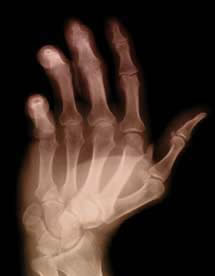 |
 |
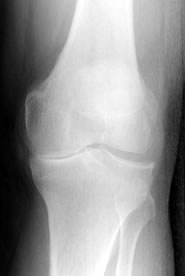 |
| Hand affected by osteoarthritis. Notice
the deformity of the finger bones. |
|
Knee affected by osteoarthritis.
Notice the narrowed space in the joint between the bones. |
Over time, small abnormal bone growth in the edge of the joints
called bone spurs or osteophytes
can add to the loss of joint motion. These spurs can even break
off and jam the joint space between the bones, causing even more
pain and damage.
Unlike other forms of arthritis (there are about 100 distinct
types), osteoarthritis does not affect internal organs.
| Healthy Joint |
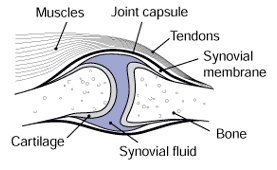 |
| In a healthy jonit, the ends of the bones
are covered by smooth cartilage tissue. The joint capsule
is lined with synovial membrane and filled with synovial fluid
that protect and lubricates the joint. |
| |
| Osteoarthritic Joint |
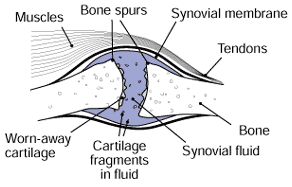 |
| In osteoarthritis, the cartilage is worn
away and bone spurs may grow from the edge of the bones. Bone
spur and cartilage fragments are often found in the synovial
fluid. In some cases, the space between the bones in the joint
narrows. |
Symptoms of Osteoarthritis
The symptoms of osteoarthritis include:
- Pain in 1 or more joints
In some people, the pain is more frequently felt in the morning
when getting out of bed. The pain tends to be sporadic and temporary
in early cases of osteoarthritis, and can develop to become
persistent in advanced cases.
- Stiffness in a joint
- Difficulty in moving the joint
- Limited range of motion in a joint
The symptoms of osteoarthritis may worsen with physical activity.
In osteoarthritis affecting specific joints, the following symptoms
are often seen:
- In finger osteoarthritis, Heberden's nodes
or enlargement in the end joints of the fingers and Bouchard's
nodes or enlargement in the middle joints are seen.
Although in most cases they are not painful, they can develop
suddenly and become inflamed, swollen, red, and painful in a
condition called nodal osteoarthritis.
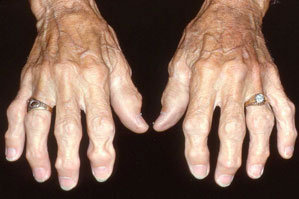
Heberden's nodes and Bouchard's nodes
- Bone spurs in osteoarthritis of the spine can pinch or crowd
spinal nerves that cause pain as well as weakness in the arms
and legs.
Osteoarthritis often affect the joints in the fingers and thumbs,
neck and spine, as well as weight-bearing joints such as the hips,
knees, and feet. In rare cases, it can also affect the elbow.
How is it Diagnosed?
Your doctor would perform the following tests to diagnose osteoarthritis:
- Physical examination
Your doctor would check the patient's reflexes and muscle strength,
and observe the affected joint. Physical tests such as the ability
to walk and bend can also be done.
- X-Ray
X-rays can show the narrowing of the space between the bones
in a joint, the presence of bone spurs, and hardening of the
bones.
- MRI and CT Scan
Magnetic Resonance Imaging (MRI) and Computed Tomography (CT
or CAT) Scan are non-invasive imaging techniques that can visualize
the structures within the joint.
- Joint fluid analysis and blood test
These tests are done not to diagnose osteoarthritis, rather
to disprove infection as the underlying cause of the symptoms.
Causes of Osteoarthritis
The following factors can increase the risk of developing this
condition:
- Age
Bone becomes more brittle, more prone to damage and less able
to heal with age. As people grow older, they are more likely
to develop osteoarthritis.
- Gender
Women are more prone to developing osteoarthritis than men.
- Genetics
Although not well understood, it is thought that the tendency
to develop osteoarthritis may be genetically inherited.
- Obesity
Because stress of the bone is increases with heavier body weight,
obesity can contribute to the development of osteoarthritis,
especially in weight-bearing joints such as the hips and knees.
- Joint Injury
Major traumatic injury to the bone, such as a bone break can
cause damage to the cartilage as well as improper alignment
of bones in the joint. Microtrauma, such as repetitive motion
of the fingers of a typist, can occur over a long time.
- Diseases
These include: diabetes and endocrine disorders, metabolic diseases
such as Paget disease and Wilson disease, congenital musculoskeletal
abnormalities such as unequal leg length, as well as inflammatory
diseases such as gout, rheumatic arthritis, and joint infection.
Treatment of Osteoarthritis
For early cases of osteoarthritis, lifestyle changes and exercise
may help limit the progression of the disease. These include:
- Losing weight
- Low-impact exercise to strengthen the muscle and potentially
stimulate cartilage growth
- Adding vitamins C, D, and E, as well as calcium
- Using orthoses or corrective devices, such as splints and
braces to help correct joint alignments and provide more support
to the body.
The pain of osteoarthritis can be managed by using:
- Heat from hot soaks or warm wax (paraffin) application.
- Over-the-counter analgesic creams, such as those containing
capsaicin, menthol and camphor.
- Over-the-counter medications, such as acetaminophen, nonsteroidal
anti-inflammatory drugs (NSAIDs), such as aspirin, ibuprofen,
and naproxen.
- Prescription medications, including COX-2 inhibitors. Note
that recently, COX-2 inhibitors have been shown to increase
the risk of heart attack and stroke.
- Injection of corticosteroids.
For severe cases of osteoarthritis, surgery maybe the only treatment
option. There different types of surgeries include:
- Arthroplasty
Replacement of the joint surface with metal or plastic.
- Arthrodesis
Fusion of the bony ends of the joint to prevent joint movement,
and thus end the pain associated with motion.
- Chondroplasty
This surgery repairs the cartilage of the bone.
- Joint replacement
In this surgery, the damaged knee or hip joints are replaced
with an artificial joints.
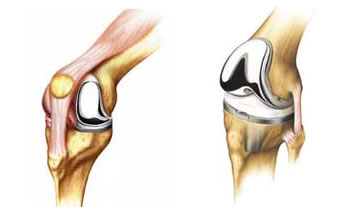 Partial and total joint replacement of the
knee.
Partial and total joint replacement of the
knee.


